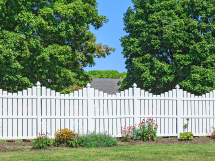A wood fence can enhance the aesthetic appeal and functionality of your property significantly. But the unique weather patterns and environmental conditions of Chicago present distinct challenges that can impact the durability and performance of wood fences. By understanding these factors and implementing proven maintenance strategies, you can prolong the life of your fence and ensure it continues to add value to your home.
Understanding the Climate’s Impact on Wood Fences
Challenges Posed by Chicago's Weather Patterns
Chicago experiences a wide range of conditions, from harsh winters with freezing temperatures to hot, humid summers. Repeated freeze-thaw cycles and moisture drive wood to expand and contract, which stresses boards and rails and can weaken joints. Lake effect snow, ice, and high winds add extra load, loosening fasteners and shifting posts out of plumb.
Summer heat and UV exposure dry the wood, increasing the risk of cracking, cupping, and warping over time. Regular sealing, proper drainage, and secure hardware help the fence withstand these swings.
How Seasonal Changes Affect Fence Durability
Frequent freezing and thawing during seasonal transitions can create moisture issues such as frost heave around fence posts. This environment can enhance rot and decay unless properly mitigated through durable materials and preventive maintenance measures.
Importance of Using Quality Fence Materials
Optimal Wood Choices for Longevity
Choosing woods such as cedar or redwood, known for their natural resistance to insects and decay, is crucial in prolonging your fence's lifespan. Pressure-treated wood is another excellent option for increased durability.
Selecting Weather-Resistant Hardware and Fasteners
Using galvanized or stainless steel hardware prevents rust and corrosion, ensuring secure connections and structural integrity over time.
Enhancing Fence Longevity with Proper Staining
Steps for Effective Fence Staining
First, clean the wood thoroughly to remove dirt and old stain. Apply a high-quality wood stain using a brush or sprayer, ensuring even coverage. Allow the stain to penetrate before applying a second coat if necessary.
Maintaining Stained Fences for Long-Term Benefits
Periodically reapplying stain every few years preserves the wood's protective properties. Also, cleaning and inspecting the fence regularly helps maintain its aesthetic appeal and strength.
Preventative Measures for Fence Posts
Installing Posts to Reduce Rot Risks
Sink fence posts in concrete foundations with proper drainage to prevent water accumulation. This minimizes the exposure to moisture that often leads to rot.
Routine Inspections and Timely Repairs
Conduct regular inspections of your fence posts for signs of wear or damage, such as cracks or splitting wood. Prompt repairs mitigate further deterioration and extend the fence's life span.
Plans, Permits, and Expert Installation From Start to Finish
Choose a partner that knows the process. Americana Iron Works & Fence prepares accurate plans, confirms property limits, and manages city reviews. We set the schedule, meet inspectors, and document each step. Expert installs and repairs for wrought iron, aluminum, and chain link. Gates that swing true. Hardware that lasts. One team from site check to final walk-through.
Key Takeaways
Prolonging the life of a wood fence in Chicago requires understanding its climate-specific challenges, such as temperature fluctuations and moisture-related issues.
Selecting high-quality, weather-resistant wood, such as cedar or redwood, and durable hardware is essential for long-term fence durability.
Properly staining a wood fence enhances its appearance and provides protection against environmental stressors.
Installing and maintaining fence posts with concrete foundations and adequate drainage helps prevent rot and ensures structural stability.
Regular inspections, cleaning, and timely repairs assist in maintaining the wood fence’s performance and aesthetic appeal.
Conclusion: Prolonging the Life of Your Wood Fence
By considering Chicago's climate and utilizing quality materials, protective stains, and preventative practices, you can ensure your wood fence remains both beautiful and functional for years to come. Proactive maintenance is an investment in your fence's longevity and in the value it adds to your home.
Ready to secure your property with a professional fence.
Call us for your wood fence services.
Frequently Asked Questions
What are the best wood types for fences in Chicago's climate?
Cedar and redwood are excellent choices for fences in Chicago due to their natural resistance to insects and decay, which helps them withstand the region's challenging weather conditions.
How can staining improve the lifespan of a wood fence?
Staining protects wood by sealing it against moisture and preventing decay. Regular reapplication of stain maintains this protective barrier, ensuring the wood's durability over time.
What hardware materials are recommended for wood fences in humid climates?
Using galvanized or stainless steel hardware is best for humid climates as they resist rust and corrosion, ensuring long-lasting stability and aesthetic appeal.
What is the significance of concrete foundation for fence posts?
Setting fence posts in concrete foundations with proper drainage reduces water exposure, preventing rot and enhancing the fence's structural longevity.
How often should fence inspections be conducted?
Regularly inspect your fence, ideally every six months or after severe weather events, to identify and address damage promptly, preserving its functional and visual integrity.

